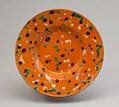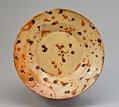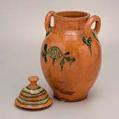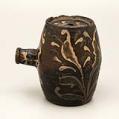Collection: Mariner Southern Ceramics Gallery: Design
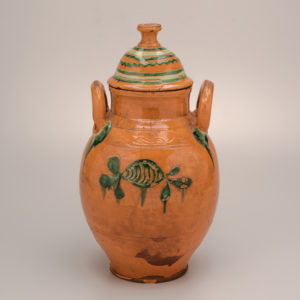
Covered Jar
Attributed to Christian Buck
Wythe County, Virginia
1800-1830
Lead-glazed earthenware
HOA: 15 7/8″; WOA: 8 1/2″
The William C. and Susan S. Mariner Collection (5813.5)
Ceramics have always been made with utility in mind, and most scholars might suggest that form is the overriding consideration when providing for the necessities of Southern agrarian life. Yet others might argue that decoration and embellishments cannot be separated from the overall intent of the maker and the desires of the consumer. The decorative vocabulary of Southern pottery encompasses a universal desire to communicate aesthetic messages through embellishment and design.
The colorful slipware dishes of Solomon Loy, made in the North Carolina Piedmont in the mid-nineteenth century, are surprisingly contemporary in appearance. Using the techniques of early Middle Eastern potters to create earthy splatters of color, these dishes foreshadow the Abstract Expressionist movement of mid-twentieth-century artists.
The small, black-glazed bottle decorated with bright yellow and green slip exemplifies a uniquely Southern expression of an immigrant Germanic tradition. Made by a somewhat mysterious group of early slipware potters working in the St. Asaph’s Tradition in Alamance Country, North Carolina, its decorative elements are still not yet fully understood within the historical context of the North Carolina Piedmont.
This elongated, covered jar dipped in bright orange slip is also enigmatic. Its distinctive two-handled form is attributed to a group of Germanic artisans working in Wythe County, Virginia. Achieving a full understanding of the potter’s intent and the historic function of its form and decoration is just one of the compelling quests for twenty-first century ceramic scholars.

